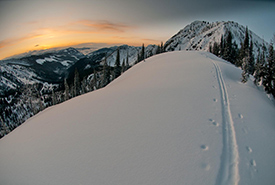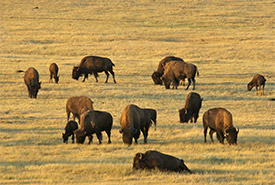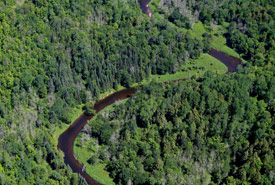Wrapping up the Natural Areas Conservation Program

Darkwoods, BC in March (Photo by Bruce Kirkby)
When I started working for the Nature Conservancy of Canada (NCC) in early 2017, I was excited to be joining a tremendously successful conservation organization with a stellar track record of success. As someone who loves to spend time outdoors and who believes that the conservation of Canada’s natural habitats should be a top priority for governments and citizens alike, it was a good fit. I was given the opportunity to apply my love of nature into (paid!) action.
A core responsibility of my job is to promote NCC’s successful partnership with the Government of Canada, known as the Natural Areas Conservation Program (NACP). It wasn’t long before I realized just how much the program meant to private conservation in Canada. The program was established in 2007. Since then, it has allowed NCC, Ducks Unlimited Canada (DUC) and other land trusts to conserve more than 1.1 million acres (450,000 hectares) of habitat across Canada.
Related content
When broken down into habitat types, that 1.1 million acres (450,000 hectares) becomes even more impressive. Of the 1.1 million acres, nearly 124,000 acres (50,000 hectares) are grasslands, 740,000 acres (300,000 hectares) are forest and more than 30,000 acres (12,000 hectares) are lakes and wetlands. It also includes close to 100 kilometres of marine coastal habitat. All told, these lands and waters provide habitat for more than 210 species assessed as at risk by the Committee on the Status of Endangered Wildlife in Canada.

Plains bison, Old Man on His Back Prairie and Heritage Conservation Area, SK (Photo by NCC)
What also became clear to me was that this success couldn’t happen without the hard work of the fundraisers and relationship-builders at NCC, DUC and the other land trusts. The NACP requires a two-to-one match; this recipe means two parts investment from NCC and partners, to one part Government of Canada investment. Thanks to the hard work of my colleagues, the $345 million invested by the Government of Canada has been matched by more than $650 million from NCC, DUC and other land trusts across Canada. The program is nearing the $1-billion milestone — an unprecedented level of private conservation in Canada.
One of the many joys of my job is that I am constantly exposed to several inspiring conservation projects across Canada. Here are some highlights that, to me, represent the power of the program:

Kenauk, QC (Photo by Mike Dembeck)
- Darkwoods in BC represents conservation on a grand scale in one of Canada’s most iconic landscapes. It provides important habitat for grizzly bear, which has been assessed as a species of special concern.
- Old Man on His Back Prairie and Heritage Conservation Area in Saskatchewan is a grasslands gem and home to reintroduced plains bison.
- The Irene Ockenden Alvar Tract in southeastern Ontario was donated by Dr. Kenneth Ockenden in honour of his late wife. It is home to a breeding program for endangered eastern loggerhead shrike.
- Kenauk in Quebec is a 15,000-acre (6,000-hectare) wonderland containing 60 lakes. Its lands and waters also have a rich history. It was granted as a seigneurial domain in 1674 by Louis XIV, King of France, to Monseigneur Laval, the first bishop of Quebec.
- Riverside – Albert, a small but mighty project, protects the water supply for a New Brunswick community. It serves as an excellent demonstration of humanity’s connection to nature.
After more than 12 years of success, the NACP is nearing its scheduled end. Fortunately, the Government of Canada announced additional funding for private conservation in Canada in its 2018 Budget, including a new program that will take its place. As NCC awaits details on how the new program will take shape, I am resting easy knowing that the momentum created by the NACP will not be lost.

